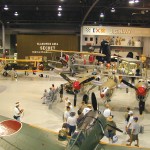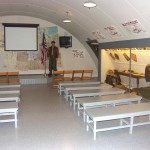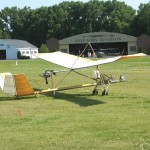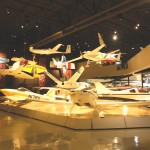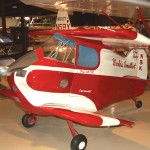By Henry M. Holden
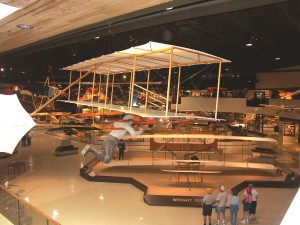
Greeting visitors on the main floor is a replica of the 1903 Wright Flyer built by students at the Blackhawk Technical Institute, in Janesville, Ohio, in 1978.
Orville and Wilbur Wright, bicycle mechanics and self-taught engineers, were convinced that manned, powered flight was possible. So was Leonardo da Vinci, who was the first to draft aircraft plans.
Between 1488 and 1514, da Vinci recorded drawings and descriptions of a helicopter and other flying machines. However, it would be centuries before technology and design caught up to each other. The fruits of the last 100 years of these efforts are on display at the EAA AirVenture Museum, in Oshkosh, Wis. This museum could also be called the “museum of innovations,” where dreamers built what they envisioned.
Located at the site of the world’s largest aviation event—EAA AirVenture—the museum has one of the most unique aviation collections in the world. It houses not only the history of homebuilt aircraft, but many one-of-a-kind homebuilt, replica and production aircraft.
This collection of historic artifacts began in 1962, when the late Steve Wittman donated his famous air racer “Bonzo.” Since then, it’s flowered into an assortment of over 20,000 historic aviation objects, many rare or unique, including about 250 airplanes.
The Women with Wings exhibit focuses on the impressive contribution made by women to aviation development. An array of historic artifacts and clothing items worn by female aviators has been recently added to supplement and improve the existing video wall display. Examples include a complete costume worn by an early female barnstormer, uniforms worn by an original Rosie the Riveter and a WASP pilot during World War II, and a flight suit worn by U.S. Aerobatic Champion Patty Wagstaff.
You can spend time in one of the five movie theaters, or witness a piece of history in the Eagle Hangar. Placed strategically around the cavernous museum are exhibits on the history of engine development, including piano-size inverted in-line engines from the early airmail planes to the giant engines that powered America’s bombers during the war. There’s a tribute to World War II aviation, an aircraft carrier bridge with pilot ready room, and a huge display of U.S. Army Air Force activities in England and Europe.
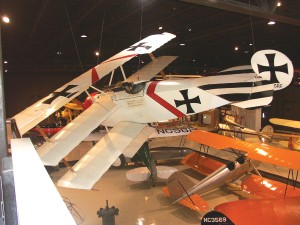
In silent flight over a Curtiss JN-4 Jenny is a nearly exact replica of a Fokker Dr. 1 Dreidecker, wearing the white, black and red markings of Jasta 11, the squadron of the Red Baron, Manfred von Richthofen.
The KidVenture Gallery is a brand-new, interactive, hands-on gallery that is fun for all ages. Want some hands-on fun? Try one of the amazing flight simulators in the museum, like the Wright Flyer Simulator, or a five-minute thrill ride in EAA’s F-16, 360-degree, full-motion MaxFlight Simulator. And don’t miss your chance to fly a hot air balloon, a hang-glider or a remote controlled airplane simulator!
A short tram ride from the museum takes you to Pioneer Airport, where, during the summer months, weather permitting, you can take a ride in a vintage airplane. Pioneer Airport is a unique living history and re-creation of what airports were like during the early days of air travel.
More than 50 vintage airplanes of aviation’s Golden Age of the 1920s and 1930s are displayed in seven period hangars. Fascinating displays include a tribute to Steve Wittman, the legendary air racer, designer and builder.
Younger visitors can enjoy a play area with swings and pedal planes. For youth ages 8 through 17, a free Young Eagles airplane flight may be available.
Most important, Pioneer Airport is a place to visit the sights and sounds of vintage flying machines in their “natural habitat.” Weather permitting, flights take place from Pioneer Airport’s grass runway every day during the season. You may also see demonstration flights from planes such as EAA’s replica of Charles Lindbergh’s “Spirit of St. Louis,” or the Pitcairn Mailwing biplane once flown by Howard Hughes.
Pioneer Airport is open on Fridays, Saturdays and Sundays from the first weekend in May until the second weekend in October. From Memorial Day to Labor Day, it’s open every day, but is closed for some flights during the annual EAA AirVenture convention, although the hangars are open for visitors.
For more information, call 920-426-4818 or visit [http://museum.eaa.org/].
- The museum has many interesting airplanes and none compete with each other for room.
- At the museum, you’ll find a tribute to World War II aviation, an aircraft carrier bridge with pilot ready room, and a huge display of U.S. Army Air Force activities in England and Europe.
- Contrast the Flyer with the 1912 Curtiss Pusher, “Sweetheart,” the first airplane imported to Wisconsin, from California.
- A modern ultralight parked in front of Pioneer Airport belies the true nature of its hangars.
- When designing the prototype RV-3 (far left), Dick Van Grunsven incorporated simple construction and attention to aerodynamic detail, resulting in an aircraft capable of high cruise speeds, low landing speeds, short field capability and aerobatic performa
- Ray Stits’ homebuilt “Sky Baby” is billed as the “world’s smallest” airplane. It has a wingspan of 7’2”, an overall length of 9’10”, and a weight of just 452 lbs.












